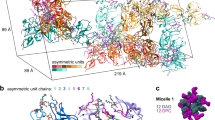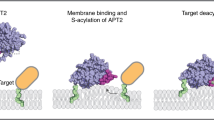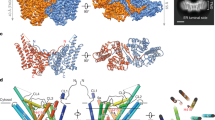Abstract
C1 domains are lipid-binding modules that regulate membrane activation of kinases, nucleotide exchange factors and other C1-containing proteins to trigger signal transduction. Despite annotation of typical C1 domains as diacylglycerol (DAG) and phorbol ester sensors, the function of atypical counterparts remains ill-defined. Here, we assign a key role for atypical C1 domains in mediating DAG fatty acyl specificity of diacylglycerol kinases (DGKs) in live cells. Activity-based proteomics mapped C1 probe binding as a principal differentiator of type 1 DGK active sites that combined with global metabolomics revealed a role for C1s in lipid substrate recognition. Protein engineering by C1 domain swapping demonstrated that exchange of typical and atypical C1s is functionally tolerated and can directly program DAG fatty acyl specificity of type 1 DGKs. Collectively, we describe a protein engineering strategy for studying metabolic specificity of lipid kinases to assign a role for atypical C1 domains in cell metabolism.
This is a preview of subscription content, access via your institution
Access options
Access Nature and 54 other Nature Portfolio journals
Get Nature+, our best-value online-access subscription
$29.99 / 30 days
cancel any time
Subscribe to this journal
Receive 12 print issues and online access
$259.00 per year
only $21.58 per issue
Buy this article
- Purchase on Springer Link
- Instant access to full article PDF
Prices may be subject to local taxes which are calculated during checkout






Similar content being viewed by others
Data availability
All data produced or analyzed for this study are included in the published article (and its supplementary information files) or are available from the corresponding author upon reasonable request.
Code availability
All code is available upon reasonable request from the corresponding author.
References
Aimon, S. et al. Membrane shape modulates transmembrane protein distribution. Dev. Cell 28, 212–218 (2014).
Di Paolo, G. & De Camilli, P. Phosphoinositides in cell regulation and membrane dynamics. Nature 443, 651–657 (2006).
Lee, M. C. et al. Sar1p N-terminal helix initiates membrane curvature and completes the fission of a COPII vesicle. Cell 122, 605–617 (2005).
Almena, M. & Mérida, I. Shaping up the membrane: diacylglycerol coordinates spatial orientation of signaling. Trends Biochem. Sci. 36, 593–603 (2011).
Liu, Y., Su, Y. & Wang, X. Phosphatidic acid-mediated signaling. Adv. Exp. Med. Biol. 991, 159–176 (2013).
van Blitterswijk, W. J. & Houssa, B. Properties and functions of diacylglycerol kinases. Cell Signal. 12, 595–605 (2000).
Franks, C. E., Campbell, S. T., Purow, B. W., Harris, T. E. & Hsu, K. L. The ligand binding landscape of diacylglycerol kinases. Cell Chem. Biol. 24, 870–880 (2017). e875.
Yamada, K., Sakane, F., Matsushima, N. & Kanoh, H. EF-hand motifs of alpha, beta and gamma isoforms of diacylglycerol kinase bind calcium with different affinities and conformational changes. Biochem. J. 321, 59–64 (1997).
Abramovici, H., Hogan, A. B., Obagi, C., Topham, M. K. & Gee, S. H. Diacylglycerol kinase-ζ localization in skeletal muscle is regulated by phosphorylation and interaction with syntrophins. Mol. Biol. Cell 14, 4499–4511 (2003).
Kume, A. et al. The pleckstrin homology domain of diacylglycerol kinase η strongly and selectively binds to phosphatidylinositol 4,5-bisphosphate. J. Biol. Chem. 291, 8150–8161 (2016).
Imai, S., Sakane, F. & Kanoh, H. Phorbol ester-regulated oligomerization of diacylglycerol kinase δ linked to its phosphorylation and translocation. J. Biol. Chem. 277, 35323–35332 (2002).
Harada, B. T. et al. Regulation of enzyme localization by polymerization: polymer formation by the SAM domain of diacylglycerol kinase δ1. Structure 16, 380–387 (2008).
Jing, W. et al. T cells deficient in diacylglycerol kinase ζ are resistant to PD-1 inhibition and help create persistent host immunity to leukemia. Cancer Res. 77, 5676–5686 (2017).
Olenchock, B. A. et al. Disruption of diacylglycerol metabolism impairs the induction of T cell anergy. Nat. Immunol. 7, 1174–1181 (2006).
Zha, Y. et al. T cell anergy is reversed by active Ras and is regulated by diacylglycerol kinase-ɑ. Nat. Immunol. 7, 1166–1173 (2006).
Merida, I., Andrada, E., Gharbi, S. I. & Avila-Flores, A. Redundant and specialized roles for diacylglycerol kinases ɑ and ζ in the control of T cell functions. Sci. Signal. 8, re6 (2015).
Prinz, P. U. et al. High DGK-alpha and disabled MAPK pathways cause dysfunction of human tumor-infiltrating CD8+ T cells that is reversible by pharmacologic intervention. J. Immunol. 188, 5990–6000 (2012).
Riese, M. J. et al. Enhanced effector responses in activated CD8+ T cells deficient in diacylglycerol kinases. Cancer Res. 73, 3566–3577 (2013).
Guo, R. et al. Synergistic control of T cell development and tumor suppression by diacylglycerol kinase ɑ and ζ. Proc. Natl Acad. Sci. USA 105, 11909–11914 (2008).
Pankratz, N. et al. Genomewide association study for susceptibility genes contributing to familial Parkinson disease. Hum. Genet. 124, 593–605 (2009).
Simon-Sanchez, J. et al. Genome-wide association study confirms extant PD risk loci among the Dutch. Eur. J. Hum. Genet. 19, 655–661 (2011).
Baum, A. E. et al. A genome-wide association study implicates diacylglycerol kinase eta (DGKH) and several other genes in the etiology of bipolar disorder. Mol. Psychiatry 13, 197–207 (2008).
Weber, H. et al. Cross-disorder analysis of bipolar risk genes: further evidence of DGKH as a risk gene for bipolar disorder, but also unipolar depression and adult ADHD. Neuropsychopharmacology 36, 2076–2085 (2011).
Squassina, A. et al. The diacylglycerol kinase eta gene and bipolar disorder: a replication study in a Sardinian sample. Mol. Psychiatry 14, 350–351 (2009).
Zeng, Z. et al. Common SNPs and haplotypes in DGKH are associated with bipolar disorder and schizophrenia in the Chinese Han population. Mol. Psychiatry 16, 473–475 (2011).
Moya, P. R., Murphy, D. L., McMahon, F. J. & Wendland, J. R. Increased gene expression of diacylglycerol kinase eta in bipolar disorder. Int J. Neuropsychopharmacol. 13, 1127–1128 (2010).
Melen, E. et al. Analyses of shared genetic factors between asthma and obesity in children. J. Allergy Clin. Immunol. 126, 631–637 (2010).
Laramie, J. M. et al. Multiple genes influence BMI on chromosome 7q31-34: the NHLBI Family Heart Study. Obes. (Silver Spring) 17, 2182–2189 (2009).
Jiang, L. Q. et al. Diacylglycerol kinase-δ regulates AMPK signaling, lipid metabolism, and skeletal muscle energetics. Am. J. Physiol. Endocrinol. Metab. 310, E51–E60 (2016).
Lowe, C. E. et al. Knockdown of diacylglycerol kinase delta inhibits adipocyte differentiation and alters lipid synthesis. Obes. (Silver Spring) 21, 1823–1829 (2013).
Chibalin, A. V. et al. Downregulation of diacylglycerol kinase delta contributes to hyperglycemia-induced insulin resistance. Cell 132, 375–386 (2008).
Liu, Z., Chang, G. Q. & Leibowitz, S. F. Diacylglycerol kinase ζ in hypothalamus interacts with long form leptin receptor. Relation to dietary fat and body weight regulation. J. Biol. Chem. 276, 5900–5907 (2001).
Lung, M. et al. Diacylglycerol kinase ε is selective for both acyl chains of phosphatidic acid or diacylglycerol. J. Biol. Chem. 284, 31062–31073 (2009).
Shulga, Y. V., Topham, M. K. & Epand, R. M. Study of arachidonoyl specificity in two enzymes of the PI cycle. J. Mol. Biol. 409, 101–112 (2011).
Shulga, Y. V., Topham, M. K. & Epand, R. M. Substrate specificity of diacylglycerol kinase-epsilon and the phosphatidylinositol cycle. FEBS Lett. 585, 4025–4028 (2011).
Rodriguez de Turco, E. B. et al. Diacylglycerol kinase ε regulates seizure susceptibility and long-term potentiation through arachidonoyl–inositol lipid signaling. Proc. Natl Acad. Sci. USA 98, 4740–4745 (2001).
Marquez, V. E. & Blumberg, P. M. Synthetic diacylglycerols (DAG) and DAG-lactones as activators of protein kinase C (PK-C). Acc. Chem. Res. 36, 434–443 (2003).
Das, J. & Rahman, G. M. C1 domains: structure and ligand-binding properties. Chem. Rev. 114, 12108–12131 (2014).
Ware, T. B., Shin, M. & Hsu, K.-L. Metabolomics analysis of lipid metabolizing enzyme activity. Methods Enzymol. 626, 407–428 (2019).
Pettitt, T. R. & Wakelam, M. J. O. Diacylglycerol kinase ε, but not ζ, selectively removes polyunsaturated diacylglycerol, inducing altered protein kinase C distribution in vivo. J. Biol. Chem. 274, 36181–36186 (1999).
Franks, C. E. & Hsu, K. L. Activity-based kinome profiling using chemical proteomics and ATP acyl phosphates. Curr. Protoc. Chem. Biol. 11, e72 (2019).
Mann, M. Functional and quantitative proteomics using SILAC. Nat. Rev. Mol. Cell Biol. 7, 952–958 (2006).
McCloud, R. L. et al. Deconstructing lipid kinase inhibitors by chemical proteomics. Biochemistry 57, 231–236 (2018).
Boroda, S., Niccum, M., Raje, V., Purow, B. W. & Harris, T. E. Dual activities of ritanserin and R59022 as DGKɑ inhibitors and serotonin receptor antagonists. Biochem. Pharm. 123, 29–39 (2017).
Chen, B. C. et al. Lattice light-sheet microscopy: imaging molecules to embryos at high spatiotemporal resolution. Science 346, 1257998 (2014).
Li, D. et al. Extended-resolution structured illumination imaging of endocytic and cytoskeletal dynamics. Science 349, aab3500 (2015).
Imai, S., Kai, M., Yasuda, S., Kanoh, H. & Sakane, F. Identification and characterization of a novel human type II diacylglycerol kinase, DGKκ. J. Biol. Chem. 280, 39870–39881 (2005).
Klauck, T. M., Xu, X., Mousseau, B. & Jaken, S. Cloning and characterization of a glucocorticoid-induced diacylglycerol kinase. J. Biol. Chem. 271, 19781–19788 (1996).
Sakane, F., Imai, S., Kai, M., Wada, I. & Kanoh, H. Molecular cloning of a novel diacylglycerol kinase isozyme with a pleckstrin homology domain and a C-terminal tail similar to those of the EPH family of protein-tyrosine kinases. J. Biol. Chem. 271, 8394–8401 (1996).
Bozelli, J. C. Jr. et al. Membrane curvature allosterically regulates the phosphatidylinositol cycle, controlling its rate and acyl-chain composition of its lipid intermediates. J. Biol. Chem. 293, 17780–17791 (2018).
Breitkopf, S. B. et al. A relative quantitative positive/negative ion switching method for untargeted lipidomics via high resolution LC-MS/MS from any biological source. Metabolomics 13, 30 (2017).
Schindelin, J. et al. Fiji: an open-source platform for biological-image analysis. Nat. Methods 9, 676–682 (2012).
Goujon, M. et al. A new bioinformatics analysis tools framework at EMBL-EBI. Nucleic Acids Res. 38, W695–W699 (2010).
Sievers, F. et al. Fast, scalable generation of high-quality protein multiple sequence alignments using Clustal Omega. Mol. Syst. Biol. 7, 539 (2011).
Acknowledgements
We thank M. Ross and all members of the Hsu Laboratory for helpful discussions. We thank S. Campbell for assistance in designing DGK chimera plasmids. This work was supported by the University of Virginia (start-up funds to K.-L.H.), the National Institutes of Health (grant nos. DA035864 and DA043571 to K.-L.H.; grant no. GM801868 to T.B.W.; grant no. GM007055 to C.E.F.), the US Department of Defense (grant no. W81XWH-17-1-0487 to K.-L.H.), an NCI Cancer Center Support Grant (grant no. 5P30CA044579-27 to K.-L.H. and T.E.H.) and the Schiff Foundation (Brain Tumor Research Grant to K.-L.H. and T.E.H.). Images were acquired using the W.M. Keck Center for Cellular Imaging Zeiss 780 Confocal microscopy system at UVA (NIH OD016446).
Author information
Authors and Affiliations
Contributions
T.B.W. and K.-L.H. conceived of the project, designed experiments and analyzed data. T.B.W. performed all lipidomics experiments by mass spectrometry and analyzed all data from these studies. T.B.W. performed cloning and expression of proteins, conducted inhibition studies and performed biochemical assays. T.B.W. conducted cellular studies. T.B.W. performed all immunofluorescence experiments and analyzed results from these studies. T.B.W. performed bioinformatics analysis of DGK targeted metabolomics data. C.E.F. performed chemical proteomic experiments and data analysis. M.E.G. and T.E.H. performed liposome substrate assay and data analysis. M.Z. and A.G. performed lattice light-sheet microscopy and data analysis. K.B.K. and K.S.P. performed shRNA knockdown of endogenous DGKα in A549 cells. T.B.W. and K.-L.H. wrote the manuscript.
Corresponding author
Ethics declarations
Competing interests
The authors declare no competing interests.
Additional information
Publisher’s note Springer Nature remains neutral with regard to jurisdictional claims in published maps and institutional affiliations.
Supplementary information
Supplementary Information
Supplementary Tables 1–3 and Figs. 1–31.
Supplementary Note
DGK C1 chimera sequence
Supplementary Dataset 1
a, Results from LipidSearch analysis of both positive and negative mode ddMS2 data from DGKε-overexpressed HEK293T lipidomes. Job results for identified lipid species are filtered as outlined in Supplementary Fig. 5. Data displayed were used to generate Fig. 1b. b, Abundances of identified DAG species from DGKε-overexpressed HEK293T lipidomes following a targeted PRM analysis identifying the NH4+ adduct. Normalization is accomplished using the detected SAG-d8 internal standard and protein concentration. Data displayed were used to generate Fig. 1d. c, log2(fold change) of DAG abundances from various DGK isoforms overexpressed in HEK293T cells. All DGK isoforms are the human variant. Data displayed were used to generate Fig. 2a,b and Supplementary Figs. 8, 9 and 11. d, SILAC ratios and modified peptides of soluble proteins from DMSO (light)/ATP (heavy) treatments of HEK293T cells overexpressed with type 1 rat DGK isoforms with the ATP acyl phosphate probe. Data displayed were used to generate Fig. 3. e, Abundances of identified DAG species from type 1 human DGK isoform-overexpressed HEK293T lipidomes following a targeted PRM analysis identifying the NH4+ adduct. Data displayed were used to generate Fig. 4a. f, Abundances of identified DAG species from A549 lipidomes following doxycycline-induced shRNA knockdown of DGKα. Data displayed were used to generate Fig. 4b. g, Abundances of identified DAG species from rat DGKα WT- and lysine mutant-overexpressed HEK293T lipidomes following a targeted PRM analysis identifying the NH4+ adduct. Data displayed were used to generate Fig. 4c. h, Abundances of identified DAG species from rat DGKα WT-overexpressed HEK293T lipidomes treated in situ with ritanserin and ketanserin. Data displayed were used to generate Fig. 4d. i, Abundances of identified DAG species from type 1 rat DGK WT- and C1 chimera-overexpressed HEK293T lipidomes following a targeted PRM analysis identifying the NH4+ adduct. Data displayed were used to generate Fig. 5. j, log2(fold change) of PA abundances from various DGK isoforms overexpressed in HEK293T cells. All DGK isoforms are the human variant. Data displayed were used to generate Supplementary Figs. 10 and 11. k, Phosphorylation activity studies of type 1 DGK WT and chimera isoforms overexpressed in HEK293T soluble proteomes. Formation of radiolabeled [γ32-P] PA product is used to determine in vitro DGK activity from liposome substrates. Data displayed were used to generate Supplementary Fig. 19. l, log2(fold change) of DAG abundances from type 1 DGK isoforms overexpressed in HEK293T cells. All DGK isoforms are the rat variant. Data displayed were used to generate Supplementary Fig. 20.
Rights and permissions
About this article
Cite this article
Ware, T.B., Franks, C.E., Granade, M.E. et al. Reprogramming fatty acyl specificity of lipid kinases via C1 domain engineering. Nat Chem Biol 16, 170–178 (2020). https://doi.org/10.1038/s41589-019-0445-9
Received:
Accepted:
Published:
Issue Date:
DOI: https://doi.org/10.1038/s41589-019-0445-9



